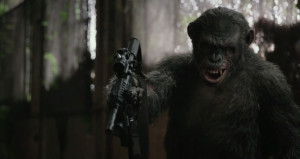Writers: Mark Bomback, Rick Jaffa, Amanda Silver
Cast: Andy Serkis, Jason Clarke, Gary Oldman, Toby Kebbell, Keri Russell, Kodi Smit-McPhee
Cert: 12A
Running time: 130mins
Year: 2014

The lowdown: Cloverfield director Matt Reeves takes director duties for this eagerly anticipated follow-up to Rupert Wyatt’s surprise 2011 hit. Set ten years after the events of Rise of the Planet of the Apes, “simian flu” has devastated humankind while apes have grown stronger and smarter. In San Francisco where it all started, an uneasy truce is observed between the apes in the Redwood forests and the human survivors huddled in the city ruins. Inevitably man and monkey must meet again, but will it mean war? Visually astounding, ambitious and smart, this is a superior slice of monkey business.
The full verdict: In Dawn of the Planet of the Apes’ opening moments chief ape Caesar prepares to lead his tribe on a hunt. As they gather in the trees, blood up for the chase, Michael Giacchino’s score slips in a sonic homage to the Black Slab theme from Stanley Kubrick’s 2001.
With this, director Matt Reeves makes intentions clear. His movie will be a big, sprawling, jaw-dropping fable about man’s battle with his inner-animal, what it means to be human and what evolution has in store for us. With special effects hitherto unseen.
And although we live in a world where the wildest imaginings can be photo-realistically realised, Dawn of the Planet of the Apes is another leap up the FX evolutionary ladder. Primarily because, as with Gravity, you would be forgiven for forgetting you’re actually watching an illusion.
These apes are the (monkey) nuts. Movement, facial expressions, the rain-soaked fake fur that should win FX supervisor Dan Lemmon an Oscar; it’s a stunning world created with no visible joins between the mo-cap monkeys and the human cast.
Whereas Michael Bay cannot get past the prettiness of his movie toy box to actually tell a story, Reeves, like Wyatt on Rise of the Planet of the Apes, has a tale to tell.
When the human survivors in San Francisco need access to a power station on a local dam before the lights finally go out, Malcolm (Clarke doing a good eco-Indiana Jones) and his team venture into the ape controlled Redwood forest.
Caesar (mo-capping Serkis again) maintains peace by keeping his fellow apes away from the humans. But, agreeing to Malcolm’s request for a few days access to the dam’s generator fires the ire of Koba (Kebbell), twisted with hatred for humans after years of vivisection.
As with Caesar and Malcolm, Koba has a counterpart in Gary Oldman’s Dreyfus, the survivor’s leader, traumatised by the death of his loved ones from simian flu and the ensuing violence and panic.
Caesar may say, “Apes… not want… war”, but Dreyfus does as does Koba. And they’re both going to go full Darwin, where only the strongest and strongest willed survive.
Reeves and his three writers commendably take time to build this near-future world before the inevitable conflict erupts.
The ape village, with sharpened tree trunks jutting out to ward off interlopers, is a living, breathing community. Entire scenes play out in sign language as apes debate the morality of strength vs diplomacy and never once lapse into the absurd, while Maurice the Orangutan makes a welcome return as the philosophical brain of the ape world.
With the supporting human cast the film goes the Pixar root, choosing talent over star wattage. The always watchable Keri Russell as Malcom’s partner and Kodi Smit-McPhee as his lad giving warm, yet haunting performances, conveying a decade of post-apocalypse endurance in a sad-optimistic smile.
But, as good as all this is, there is the thrill in watching horse-straddling, rifle-brandishing apes battling their one-time masters. Surprisingly this is where Reeves missteps. A nocturnal simian attack on the human encampment is good, particularly a virtuoso locked-off shot of Koba taking command of an urban assault vehicle, but there is nothing here to match the wide-grin awe evoked by the Golden Gate Bridge climax from Rise…
And when ape politics go fascistic, leading to an underground rebellion, and obligatory explosions and vertiginous construction tower smackdowns the film slips into formula.
Yet, even here there is room for father/son bonding and small moments of sad reflection at the cost of conflict, again placing brains above brawn.
The final moments set the stage for a spectacular Part III that may feature the story ideas original director Rupert Wyatt wanted to tell in this film.
Here’s hoping it’s another example of monkey see, monkey do good.
Rob Daniel
[youtube id=”3sHMCRaS3ao”]





